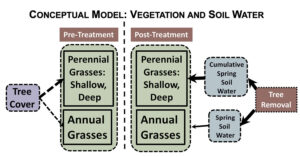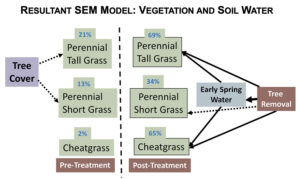This year, SageSTEP researchers are engaged in an effort to compile a number of scientific papers as a special feature in the open-source journal Ecosphere. This includes papers on vegetation, fuels and fire behavior, soils, hydrology, and biodiversity. To date, two papers have been accepted, and several more are in the review process. The collection of papers is available on the Ecosphere website.
In this piece, I want to discuss how three of those papers are related to one another. But first I need to remind you that SageSTEP was designed to provide managers with information on common land-use treatments, information that could be used for making better decisions at a project-level scale. SageSTEP uses large plots which span disturbance gradients, and is multi-site—factors that provide conditional information on treatment response. The project is long-term, because we know that it requires many years, in some cases decades, for responses to play out. And SageSTEP is a collection of multiple variables and data sets that interact in space and time. This provides the opportunity to identify tradeoffs and relationships among variables. It is this latter strength that is most emphasized by the three related papers I want to discuss.
The first paper is concerned with vegetation response in the ‘woodland’ experiment (sites encroached by pinyon-juniper trees), and was written by Stephanie Freund, a data analyst working with SageSTEP PIs Beth Newingham and Jeanne Chambers. They focused on how the vegetation understory (grasses, forbs, shrubs) responded to tree removal over a ten-year post-treatment period. The second paper is focused on soil water response at the same woodland sites, and was written by Bruce Roundy (co-authors Rick Miller, Robin Tausch, Jeanne Chambers, and Ben Rau). The third paper presents a model that ties the vegetation and soil water stories together, and is written by myself, James Grace, and Bruce Roundy.
Freund’s paper clearly shows that two of the principal functional groups of the understory vegetation (grasses and forbs) respond positively to tree removal by any means, with grasses—both annual and perennial—showing the greatest increases to both burning and cutting over the ten-year time period. This was an expected result, because it was assumed that understory species were significantly suppressed prior to treatment by pinyon and juniper trees on the landscape as a result of competition for resources, principally water (but possibly also light). If the hypothesis of competition for water were true, then we would expect to also see an increase in water resources in the soil after trees were removed, mirroring the response in the understory vegetation. This is exactly what Roundy observed for the soil water resource – substantial increases in available soil water, particularly for plots that had previously been most dominated by trees. Given these two lines of corroborating information, one would think that the ‘water competition’ hypothesis was now confirmed: that grass and forb cover increased significantly after tree removal because grasses and forbs were freed from tree competition due to the release of available soil water. But we cannot yet say this, because measurements were taken, and data analysis performed on vegetation and soil water separately, using univariate statistics, such as analysis of variance. In addition, while soil water data were taken within the same treatment plots as vegetation data, soil water measuring stations were not exactly within vegetation measurement sub-plots. This means that technically, the mirroring of response in soil water and the vegetation confirms only correlation, rather than cause and effect. This is why Freund and her co-authors use conditional language in their interpretation of vegetation response: ‘Prescribed burning and mechanical treatment likely increased resource availability, promoting growth and seed production.’
To confirm our hypothesis that grasses and forbs would increase after tree removal due in part to increases in available soil water, we need to take one further analytical step. That’s where the paper by McIver, Grace and Roundy comes in. These researchers started with a simple conceptual model that specifically detailed the ‘tree competition’ hypothesis (Figure 1), which states that tree cover explains most of the variation in grass cover pre-treatment (dashed lines indicate negative relationships).
Figure 1. Conceptual vegetation and soil water model. (Click on image to enlarge)
Note that we also hypothesize that tree cover will have a greater influence on perennial grass cover, compared to annual grass cover, as indicated by the width of the arrow connecting tree to grass cover. We then tested this hypothesis for the ‘cut and leave’ plots by analyzing both vegetation and soil water data together with a multivariate ‘structural equation’ model (SEM). SEM runs a series of algorithms with the data, that iteratively find the simplest and best-fit solution to the relationships among variables in the conceptual model. If significant relationships are found among variables that align with the predictions of the conceptual model, we can say that the resulting model is consistent with the hypothesis described by the conceptual model. This is exactly what we found in the SEM analysis (Figure 2).
Figure 2. Vegetation and soil water SEM model. (Click on image to enlarge)
First note the percentage above each grass box: this indicates the percentage of variation in each grass group that the model explains. Notice that the post-treatment model explains more variation in each group than the pre-treatment model, and this is mostly due to the fact that the post-treatment side of the model represents a second measurement event, which strengthens our confidence. Next notice that in the pre-treatment world, we found significant negative relationships only between trees and the perennial grasses, but not cheatgrass. Now notice in the post-treatment model, that tree removal caused a significant increase in early spring water (as indicated by the solid black line), which in turn caused an increase in both perennial tall grasses and cheatgrass. Interestingly, perennial short grass cover actually went down slightly with tree removal. Finally, notice that tree removal also was related directly to perennial tall grass and cheatgrass – this is the variation in plant cover not explained by soil water, and indicates that soil water increases only partly explained plant response, as reflected in the data. We can now go one step further than authors could go in the two univariate papers, and now say that vegetation response to tree removal was due in part to increases in available soil water.
Science can be a messy process, especially when you embark on the analysis of comprehensive, multi-site, mixed-gradient, multivariate, long-term data sets like that from SageSTEP. But with careful thought and persistence, sometimes we can nail things down with more confidence. Hopefully, the extensive univariate analyses that are currently being done, will increasingly be bolstered by the multivariate analyses that can offer cause and effect insight on the processes that govern vegetation growth and recovery in sagebrush steppe.
This field note written by James McIver.


